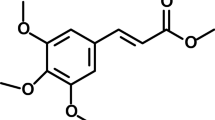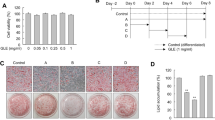Abstract
In this study, we examined the effects of (–)-epigallocatechin-3-gallate (EGCG) on anti-inflammatory responses through the induction of heme oxygenase-1 (HO-1) in cocultured macrophages and adipocytes. EGCG significantly decreased the secretion of nitric oxide (NO) and monocyte chemoattractant protein-1 in the coculture of RAW 264.7 macrophages and differentiated 3T3-L1 adipocytes. In addition, EGCG inhibited the expression of inducible nitric oxide synthase in cocultured macrophages and peroxisome proliferator-activated receptor-gamma in cocultured adipocytes. Furthermore, the HO-1 expression showed an approximately 4-fold increase in cocultured adipocytes and an approximately 6-fold increase in cocultured macrophages. Lastly, HO-1 silencing induced NO generation in cocultured cells regardless of EGCG treatment. These results indicate that EGCG inhibited inflammatory responses by suppressing the production of proinflammatory cytokines through HO-1 induction during adipocyte–macrophage interaction.
Similar content being viewed by others
References
Weisberg SP, McCann D, Desai M, Rosenbaum M, Leibel RL, Ferrante AW, Jr. Obesity is associated with macrophage accumulation in adipose tissue. J. Clin. Invest. 112: 1796–1808 (2003)
Xu H, Barnes GT, Yang Q, Tan G, Yang D, Chou CJ, Sole J, Nichols A, Ross JS, Tartaglia LA, Chen H. Chronic inflammation in fat plays a crucial role in the development of obesity-related insulin resistance. J. Clin. Invest. 112: 1821–1830 (2003)
Suganami T, Nishida J, Ogawa Y. A paracrine loop between adipocytes and macrophages aggravates inflammatory changes: Role of free fatty acids and tumor necrosis factor alpha. Arterioscl. Throm. Vas. 25: 2062–2068 (2005)
Solinas G, Vilcu C, Neels JG, Bandyopadhyay GK, Luo J L, Naugler W, Grivennikov S, Wynshaw-Boris A, Scadeng M, Olefsky JM, Karin M. JNK1 in hematopoietically derived cells contributes to diet-induced inflammation and insulin resistance without affecting obesity. Cell Metab. 6: 386–397 (2007)
Donath MY, Shoelson SE. Type 2 diabetes as an inflammatory disease. Nat. Rev. Immunol. 11: 98–107 (2011)
Cavet ME, Harrington KL, Vollmer TR, Ward KW, Zhang JZ. Anti-inflammatory and anti-oxidative effects of the green tea polyphenol epigallocatechin gallate in human corneal epithelial cells. Mol. Vis. 17: 533–542 (2011)
Lin JK, Liang YC, Lin-Shiau SY. Cancer chemoprevention by tea polyphenols through mitotic signal transduction blockade. Biochem. Pharmacol. 58: 911–915 (1999)
Lee H, Bae S, Yoon Y. The anti-adipogenic effects of (-)epigallocatechin gallate are dependent on the WNT/beta-catenin pathway. J. Nutr. Biochem. 24: 1232–1240 (2013)
Otterbein LE, Bach FH, Alam J, Soares M, Tao Lu H, Wysk M, Davis RJ, Flavell RA, Choi AM. Carbon monoxide has anti-inflammatory effects involving the mitogen-activated protein kinase pathway. Nat. Med. 6: 422–428 (2000)
Motterlini R, Foresti R, Bassi R, Green CJ. Curcumin, an antioxidant and antiinflammatory agent, induces heme oxygenase-1 and protects endothelial cells against oxidative stress. Free Radical. Bio. Med. 28: 1303–1312 (2000)
Pullikotil P, Chen H, Muniyappa R, Greenberg CC, Yang S, Reiter CE, Lee JW, Chung JH, Quon MJ. Epigallocatechin gallate induces expression of heme oxygenase-1 in endothelial cells via p38 MAPK and Nrf-2 that suppresses proinflammatory actions of TNF-alpha. J. Nutr. Biochem. 23: 1134–1145 (2012)
Kim DH, Vanella L, Inoue K, Burgess A, Gotlinger K, Manthati VL, Koduru SR, Zeldin DC, Falck JR, Schwartzman ML, Abraham NG. Epoxyeicosatrienoic acid agonist regulates human mesenchymal stem cell-derived adipocytes through activation of HO-1-pAKT signaling and a decrease in PPARgamma. Stem Cells Dev. 19: 1863–1873 (2010)
Vanella L, Kim DH, Sodhi K, Barbagallo I, Burgess AP, Falck JR, Schwartzman ML, Abraham NG. Crosstalk between EET and HO-1 downregulates Bach1 and adipogenic marker expression in mesenchymal stem cell derived adipocytes. Prostag. Oth. Lipid M. 96: 54–62 (2011)
Chang TH, Polakis SE. Differentiation of 3T3-L1 fibroblasts to adipocytes. Effect of insulin and indomethacin on the levels of insulin receptors. J. Biol. Chem. 253: 4693–4696 (1978)
Tobe K, Kasuga M, Kitasato H, Takaku F, Takano T, Segawa K. Differential effects of DNA tumor virus nuclear oncogene products on adipocyte differentiation. FEBS Lett. 215: 345–349 (1987)
Lin J, Della-Fera MA, Baile CA. Green tea polyphenol epigallocatechin gallate inhibits adipogenesis and induces apoptosis in 3T3-L1 adipocytes. Obes. Res. 13: 982–990 (2005)
Liu HS, Chen YH, Hung PF, Kao YH. Inhibitory effect of green tea (-)-epigallocatechin gallate on resistin gene expression in 3T3-L1 adipocytes depends on the ERK pathway. Am. J. Physiol.-Endoc. M. 290: E273–E281 (2006)
Lin YL, Lin JK. (-)-Epigallocatechin-3-gallate blocks the induction of nitric oxide synthase by down-regulating lipopolysaccharide-induced activity of transcription factor nuclear factor-kappaB. Mol. Pharmacol. 52: 465–472 (1997)
Hobbs AJ, Higgs A, Moncada S. Inhibition of nitric oxide synthase as a potential therapeutic target. Annu. Rev. Pharmacol. 39: 191–220 (1999)
Kanda H, Tateya S, Tamori Y, Kotani K, Hiasa K, Kitazawa R, Kitazawa S, Miyachi H, Maeda S, Egashira K, Kasuga M. MCP-1 contributes to macrophage infiltration into adipose tissue, insulin resistance, and hepatic steatosis in obesity. J. Clin. Invest. 116: 1494–1505 (2006)
Ma KL, Ruan XZ, Powis SH, Chen Y, Moorhead JF, Varghese Z. Inflammatory stress exacerbates lipid accumulation in hepatic cells and fatty livers of apolipoprotein Eknockout mice. Hepatology 48: 770–781 (2008)
Ando C, Takahashi N, Hirai S, Nishimura K, Lin S, Uemura T, Goto T, Yu R, Nakagami J, Murakami S, Kawada T. Luteolin, a food-derived flavonoid, suppresses adipocyte-dependent activation of macrophages by inhibiting JNK activation. FEBS Lett. 583: 3649–3654 (2009)
Jung HW, Yoon CH, Park KM, Han HS, Park YK. Hexane fraction of Zingiberis Rhizoma Crudus extract inhibits the production of nitric oxide and proinflammatory cytokines in LPS-stimulated BV2 microglial cells via the NFkappaB pathway. Food Chem. Toxicol. 47: 1190–1197 (2009)
Alderton WK, Cooper CE, Knowles RG. Nitric oxide synthases: Structure, function and inhibition. Biochem. J. 357: 593–615 (2001)
Tontonoz P, Singer S, Forman BM, Sarraf P, Fletcher JA, Fletcher CD, Brun RP, Mueller E, Altiok S, Oppenheim H, Evans RM, Spiegelman BM. Terminal differentiation of human liposarcoma cells induced by ligands for peroxisome proliferator-activated receptor gamma and the retinoid X receptor. P. Natl. Acad. Sci. USA 94: 237–241 (1997)
Pinent M, Espinel AE, Delgado MA, Baiges I, Blade C, Arola L. Isoflavones reduce inflammation in 3T3-L1 adipocytes. Food Chem. 125: 513–520 (2011)
Ricote M, Glass CK. PPARs and molecular mechanisms of transrepression. Biochim. Biophys. Acta 1771: 926–935 (2007)
Motterlini R, Foresti R. Heme oxygenase-1 as a target for drug discovery. Antioxid. Redox. Sign. 20: 1810–1826 (2014)
Choi JW, Lee CW, Lee J, Choi DJ, Sohng JK, Park YI. 7,8-Dihydroxyflavone inhibits adipocyte differentiation via antioxidant activity and induces apoptosis in 3T3-L1 preadipocyte cells. Life Sci. 144: 103–112 (2015)
Li M, Kim DH, Tsenovoy PL, Peterson SJ, Rezzani R, Rodella LF, Aronow WS, Ikehara S, Abraham NG. Treatment of obese diabetic mice with a heme oxygenase inducer reduces visceral and subcutaneous adiposity, increases adiponectin levels, and improves insulin sensitivity and glucose tolerance. Diabetes 57: 1526–1535 (2008)
Bruce CR, Carey AL, Hawley JA, Febbraio M A. Intramuscular h eat shock protein 72 and heme oxygenase-1 mRNA are reduced in patients with type 2 diabetes: Evidence that insulin resistance is associated with a disturbed antioxidant defense mechanism. Diabetes 52: 2338–2345 (2003)
Author information
Authors and Affiliations
Corresponding author
Rights and permissions
About this article
Cite this article
Kim, Y., Lee, J. Effect of (–)-epigallocatechin-3-gallate on anti-inflammatory response via heme oxygenase-1 induction during adipocyte–macrophage interactions. Food Sci Biotechnol 25, 1767–1773 (2016). https://doi.org/10.1007/s10068-016-0269-2
Received:
Revised:
Accepted:
Published:
Issue Date:
DOI: https://doi.org/10.1007/s10068-016-0269-2




